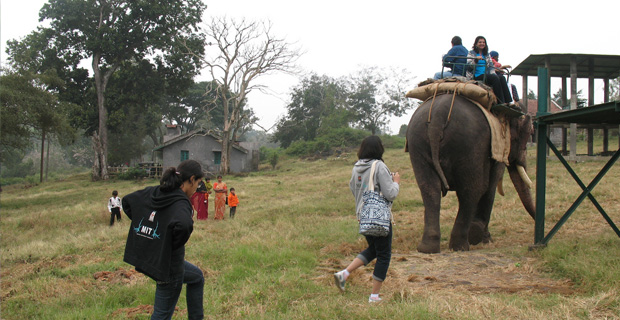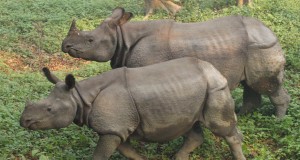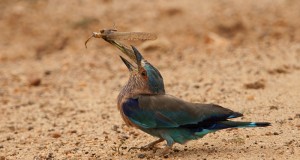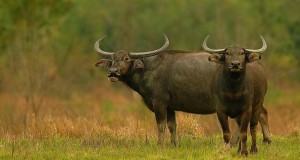The large area originally known as Wynad on the northeastern slopes of the Nilgiri mountains now holds three parks in three states. The Wynad sanctuary in Kerala to the west; Bandipur Tiger Reserve in Karnataka to the north; and Mudumalai in Tamil Nadu to the South.
The word mudumalai has the same meaning — “the ancient hill range” — in each of the languages of these three states.
The Moyar river flows north through the park and then turns east to form the northern boundary of Mudumalai, separating it from Bandipur. The park is split by the Mysore-Ootacamund highway running north-south and following the left bank of the Moyar river. Despite being only 116 sq miles (300 sq km) in area, Mudumalai has a great variety of attractive habitats.
Although the north-south highway inevitably causes some disturbance, the game viewing can be excellent. The first time visitor is advised to seek local guidance.
Birdlife: The birdlife is rich and extensive. The variety includes the beautiful Malabar trogon, the Malabar gray hornbill and the Malabar great black woodpecker with its magnificent crimson crest contrasted by its black body. The leading avian predator in the drier and more open forest areas of Mudumalai, where it is fairly common, is undoubtedly the crested hawk-eagle. The crested serpent eagle is also found. Although rarely seen, many owls can be found in the different forest types. The common scoops owl and the little scops owl are more often heard while the tiny-eared owl uses its brown marking to merge with the trees.
During the summer, many of the resident song birds such as barbets, mynas, parakeets and cuckoos fill the forest with their calls.
Elephants, Predators and Prey: While the Moyar river forms a political and administrative division, the herds of elephant, gaur and other animals move freely between Bandipur, Mudumalai and the neighboring forests. The great feline predators are only rarely seen although the tiger is present throughout the sanctuary. Leopards are most often seen in the Kargudi area. The other important predator in the area is the wild dog or dhole (Cuon alpinus) which hunt in packs.
In 1968 an epidemic of rinderpest reduced I the great herds of gaur to a few scattered groups in the outlying forest. As in Bandipur, these small groups arc now returning to their old grazing haunts. Although the Large herds of over 80 which used to be found at Theppakkadu are regrettably no longer seen, smaller composite herds are regrouping with two or more master bulls leading their respective groups.
The elephant population seen in various herds throughout Mudumalai is made up of animals migrating through the area on a seasonal basis looking for fresh fodder. Many of the old migratory trails along the Western Ghats are now cultivated hillsides and valleys. Those routes through Nagarahole, Bandipur and Mudumalai reserves continue south and west into the remnants of the great forest areas of Kerala. The two most common species in the sanctuary are the chital or spotted deer and the sambar. Both have definite local variations. The chital are usually seen in small groups throughout the sanctuary except in Benne to the southwest. In the southeast, however, near the well-watered open grasslands of the Masinagudi area, larger herds are found. At Viewpoint near Masinagudi herds of over a hundred are often seen.
Sambar are found throughout the park, but except for those in the Avarahalla- Manradiar area, they are quite small. In the Avarahalla area, however, the stags have a very distinct local identity, being much darker than usual but with smaller antlers. Another deer seen here is the solitary barking deer or muntjac which lives in the same forest habitat as the chital. An unusual sight, but more often seen here than elsewhere in India, is the tiny mouse deer or Indian chevrotain ( Tragulus nieminna), usually camouflaged with its light-cream mottled pattern on its brown coat.
Of the other mammals, the wild boar is the one Most often seen, especially along the streams, on the banks of pools or crossing a culvert. In the clearings near Theppakkadu in the north and at Kargudi at the center, both bonnet macaques and common langurs are found. Occasional sightings of the giant squirrel are made, although they are more often only heard. Flying squirrels, being nocturnal, are rarely observed. The only reptile regularly seen is the monitor lizard, especially along the road to Mayar powerhouse in the northeast corner. As in most of the region, the best period for game-viewing is the summer months (March June).





